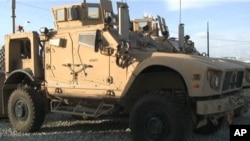Explosive Devices have accounted for around 800 of the roughly 1,100 U.S. combat deaths in Afghanistan. To counter these increasingly-lethal bombs, the U.S. military is spending billions of dollars on blast-resistant vehicles specially tailored for Afghan terrain. But in addition to their high cost, the complex new vehicles can be a logistical burden.
In Dangam district, eastern Afghanistan, the U.S. Army's 173rd Airborne Brigade is on its way to a meeting with district officials. To reach the meeting, the soldiers must cross a wide riverbed. Previously, this would have been a problem.
On several occasions, the Taliban have ambushed vehicles mired in the riverbed's rough terrain.
The lightweight, standard-issue Humvee is vulnerable to enemy fire and the heavier Mine-Resistant, Ambush-Protected truck (MRAP) is too top-heavy for steep inclines.
Fortunately, the troops of the 173rd Airborne have just received their first All-Terrain Vehicle version of the MRAP, the M-ATV. The 15-ton vehicle is nimble enough for rough terrain and sufficiently armored to deflect all but the biggest bombs.
The MRAP vehicle has its roots in the Iraq war. Improvised Explosive Devices wreaked havoc with the boxy, M-1151 Humvees. With their v-shaped bottoms, the MRAPs deflected blasts and saved hundreds of American lives.
But in Afghanistan, the MRAPs tended to roll over on mountain roads. So the Pentagon awarded a $4 billion contract to build a version with a lower center of gravity and improved suspension. The first of 6,000 M-ATVs arrived in Afghanistan late last year.
At Bagram airfield outside Kabul, Sergeant First Class Randy Geringer helps train 82nd Airborne Division soldiers to drive the M-ATV. Geringer has nothing but praise for the vehicle.
"The MRAP ATV for this type of terrain I feel is more versatile, with the tire inflation system," said Geringer. "It's more rugged vehicle and I think it would handle the terrain a little bit easier than some of the other vehicles."
But in addition to their high cost -- three times that of a Humvee -- the M-ATVs are mechanically complex. Staff Sergeant Richard Green, an 82nd Airborne Division mechanic, found this out first-hand when he accidentally damaged his unit's first M-ATV.
"There's a nut on the inside of the oil pan. The bolt came out. But the nut was not welded correctly to the oil pan, so the nut fell off. The bolt comes out and there was no way to hold the oil in the pan. So we had to take the engine pack out and replace it," recalled Green.
The M-ATVs are also a major logistical challenge. The Pentagon transports them by air in order to meet the high demand, adding a 10-percent premium to the vehicle's cost.
Then, it can take a team of 10 people several hours to unload a shipment of five M-ATVs. On a 747 freighter, there are just centimeters of clearance between the M-ATVs and the plane's sides.
In combat, the frontline soldiers don't care about the M-ATV's logistical burden. They only care that it's safer and better-protected than other vehicles.
"I would feel more confident, comfortable and safe going outside the wire in one of the MRAP variants than I would in the 1151s," noted Geringer.








